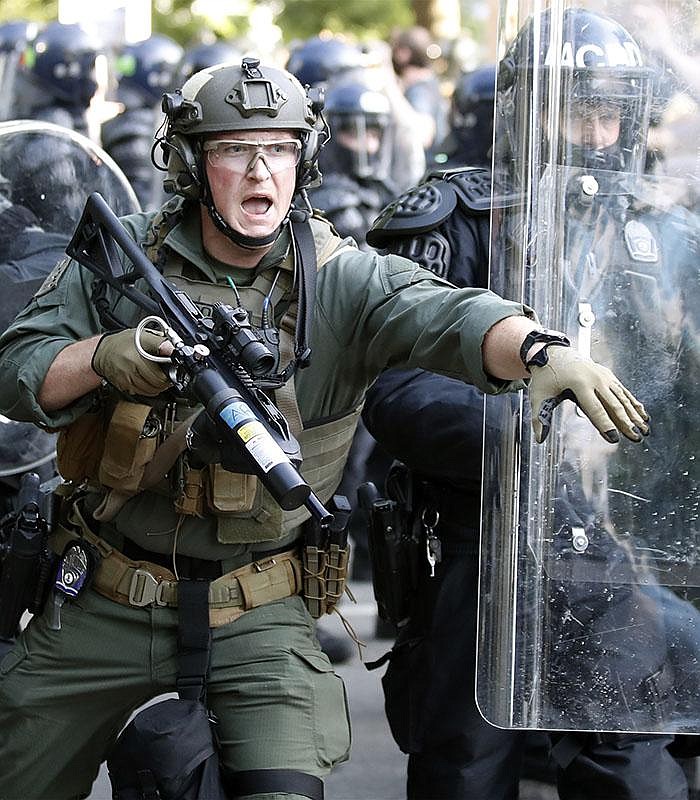NEW YORK -- In law enforcement, they're referred to as "nonlethal" tools for dealing with demonstrations that turn unruly: rubber bullets, pepper spray, batons, flash-bangs.
But the now-familiar scenes of U.S. police officers in riot gear clashing with protesters at Lafayette Park across from the White House and in other cities have police critics asserting that the weaponry too often escalates tensions and hurts innocent people.
"When you see riot gear, it absolutely changes the mood," said Ron Moten, a longtime community organizer in the nation's capital. He said it takes away any perception that the officers could be empathetic.
"If I went up to speak with a police officer and I'm covered in armor and holding a shield and a stick, don't you think they would regard me as a threat?"
"When we see riot gear, as black people it takes us back 400 years," he said.
Protesters in Denver arrived at the hospital with injuries from police projectiles that caused one person to lose an eye and left three people with permanent eye damage, said Prem Subramanian, a doctor who operated on some of the victims.
"They weren't accused of any crime, and they came in with devastating eye injuries," Subramanian said, adding that he was so upset about it that he complained to city officials, who promised to investigate any abuses. "We're learning the consequences of using these weapons."
He said the injuries rivaled what he saw treating shrapnel damage to the eyes of soldiers injured by explosives in Iraq and Afghanistan.
Rubber bullets and similar projectiles have damaged eyes or blinded at least 20 people from ages 16 to 59 since protests began over the death of George Floyd in Minneapolis, according to the American Academy of Ophthalmology.
Other tactics were on display in Washington, where police used chemical agents to break up a peaceful protest minutes before President Donald Trump posed for pictures outside a church this month. In Buffalo, an officer used a baton to shove a 75-year-old man to the ground before police marched past as blood collected beneath the man's head.
Amnesty International has questioned whether equipping officers "in a manner more appropriate for a battlefield may put them in the mindset that confrontation and conflict are inevitable."
The growing use of less lethal weapons is "cause for grave concern" and may sometimes violate international law, said Agnes Callamard, director of Global Freedom of Expression at Columbia University and a United Nations adviser.
She said the "basic rationale for less lethal weaponry is legitimate" after courts called for law enforcement agents to be given equipment enabling them to respond proportionately when necessary. In 1990, the U.N. issued basic principles on their use.
Wade Carpenter, police chief in Park City, Utah, said the tools are necessary when peaceful rallies are "hijacked by individuals that have come in with a nefarious purpose to create the riots, the looting, those type of things."
Many police forces "are very stringent on their training," said Carpenter, an official with the International Association of Chiefs of Police. "They're very accountable, and others, you know, it's kind of all over the board."
Officers target lawbreakers who attack police with bricks or baseball bats, but sometimes less-than-lethal options are "not perfectly accurate, so that's always a risk, and those are calculated risks," Carpenter said.
Seattle's mayor and police chief early this month banned tear gas for 30 days before a federal judge ordered the city to stop using pepper spray, flash-bang grenades and rubber bullets. A Dallas judge made a similar ruling.
Acting on a federal lawsuit, a judge in Denver temporarily limited the use of projectiles and tear gas, finding a strong likelihood that the police department violated constitutional rights.
In early June, the police chief in Austin, Texas, said his department would no longer fire beanbag projectiles at crowds after two demonstrators were hospitalized after being hit in the head, including a 16-year-old boy.
In New York City, the police department has not used rubber bullets or tear gas during protests. At a City Council hearing, police officials were pressed on whether officers should even be armed with batons after the city's mayor promised "minimum force."
First Deputy Police Commissioner Benjamin Tucker responded that helmets and batons, necessary to protect officers, "are not window dressing."
Information for this article was contributed by Ashraf Khalil of The Associated Press.



